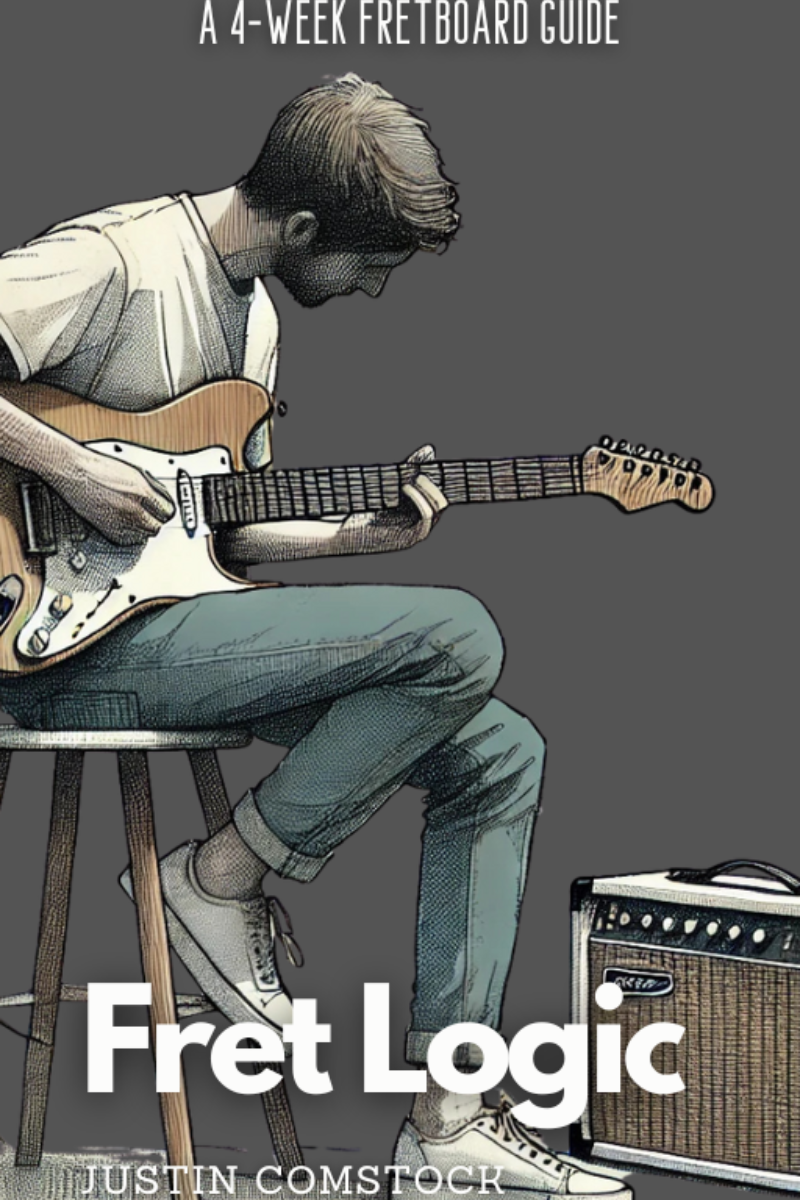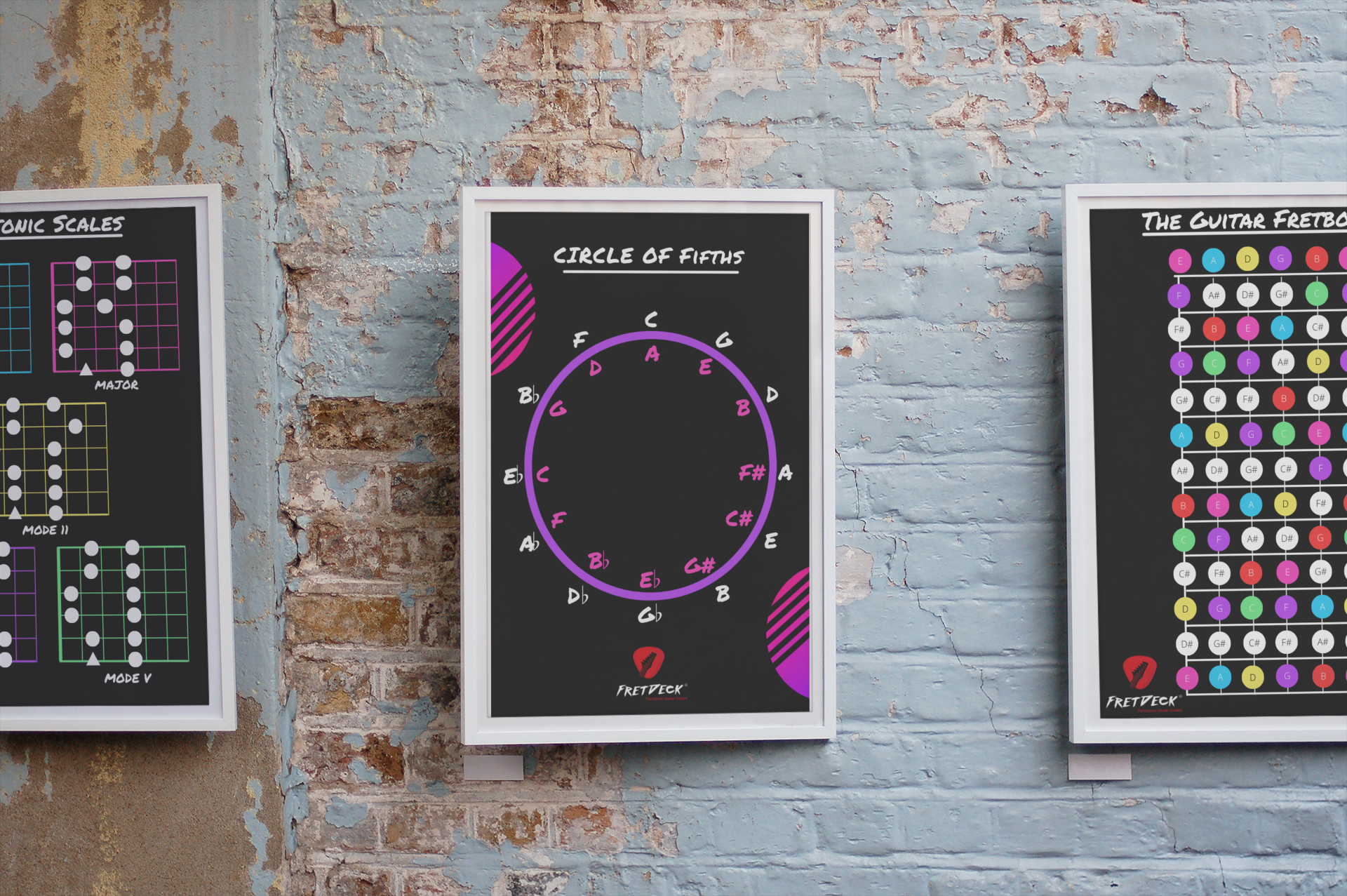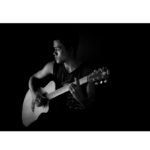Let’s be honest. Most guitarists—especially beginners—struggle not because they lack discipline, but because they lack direction.
You open a songbook. You see chord names. You fumble. You Google. You see a hundred diagrams, and you’re still not sure where your fingers go or why they matter.
Here’s the truth:
A guitar chords chart is not just a cheat sheet—it’s a gateway to understanding music visually.
And in this post, I’ll show you how to really use chord charts to unlock the fretboard. You’ll learn how to:
- Read and apply chord diagrams like a seasoned pro
- Connect chords and scales for improvisation
- Build real fretboard fluency, not just shape memorization
- Use a tool called FretDeck™ to practice smarter, not harder
By the end, you’ll know exactly how to use guitar chords charts to elevate your playing, deepen your knowledge—and sound way more confident.

❌ Stop Guessing. Start Shredding.
If you’re still fumbling through scale patterns and box shapes… it’s costing you progress.
FretDeck™ is the no-fluff system that shows you exactly how to master the fretboard—fast. Early access.
⚡️ This isn’t for dabblers. It’s for players who want results.
👉 Click here to join the pre-launch now
Early access. Limited rewards. Don’t wait.
What Is a Guitar Chords Chart (Really)?
A guitar chords chart is a visual diagram that shows you exactly how to play a chord—where to place your fingers, what strings to mute, and which notes ring open.
Most charts contain:
- Vertical lines = guitar strings (low E to high E, left to right)
- Horizontal lines = frets
- Dots = where your fingers go
- Numbers = which finger to use (1 = index, 4 = pinky)
- O and X above strings = open or muted
Think of it as a GPS for your fingers—but only if you know how to use it.
How to Read a Guitar Chords Chart (And Actually Remember It)
Let’s use the C major chord as a classic example:
e|---0---
B|---1---
G|---0---
D|---2---
A|---3---
E|---X---
- X over low E = don’t play it
- 3 on A = ring finger, 3rd fret
- 2 on D = middle finger, 2nd fret
- 1 on B = index finger, 1st fret
- 0s = play strings open
Read it vertically. Apply it slowly. Repeat it until you feel it in your hand—not just your head.
Want 27 charts like this you can actually use in songs?
Download your free guitar chords chart pack here →
Start With These 4 Chords (And You’ll Know Half the Songs Ever Written)
If you’re new to guitar or just cleaning up sloppy rhythm work, start here:
1. G Major
e|---3---
B|---0---
G|---0---
D|---0---
A|---2---
E|---3---
2. C Major
As seen above. A timeless go-to.
3. D Major
e|---2---
B|---3---
G|---2---
D|---0---
A|---X---
E|---X---
4. E Minor
e|---0---
B|---0---
G|---0---
D|---2---
A|---2---
E|---0---
Master transitions between these chords at a slow tempo with a metronome. Then plug them into actual progressions like G–C–D–G or Em–C–G–D.
Unlock More Chords with Barre Shapes
Open chords are great—but you need to move beyond the first three frets. That’s where barre chords come in.
Here’s the F major barre shape (based on the E major shape):
e|---1---
B|---1---
G|---2---
D|---3---
A|---3---
E|---1---
Move it up 2 frets: it’s G major
Move it up 5 frets: it’s A major
Barre chords are your ticket to full fretboard freedom.
Learn how to visualize these using the FretDeck Kickstarter Deck—a visual training system that turns theory into muscle memory.
Back FretDeck™ now →
Guitar Chords Chart = Your Scale Cheat Code
Most people use chord charts for rhythm. That’s a mistake.
What most players miss is this: Your chord shapes are your roadmap to soloing.
Every chord is surrounded by scale tones—and once you see how the chord sits inside the scale, you can solo over progressions without getting lost.
Let’s take the A minor chord:
mathematicaCopyEditA minor chord notes: A – C – E
A minor scale: A – B – C – D – E – F – G
A minor pentatonic: A – C – D – E – G
If you know that shape, and that scale lives around it, you can now solo in position instead of running up and down the neck blindly.
This is where FretDeck™ shines.
With each scale shape and chord progression mapped visually, FretDeck shows you how to see the notes under your fingers—not just memorize patterns.
🎯 Want to solo with intention?
FretDeck: Pentatonic Scales gives you:
- All 60 pentatonic scale patterns in every key
- Chord-to-scale visualization
- Practice prompts for phrasing
- And the stretch-goal Progressions Deck if we hit $15k
👉 Join the FretDeck Kickstarter Now

❌ Stop Guessing. Start Shredding.
If you’re still fumbling through scale patterns and box shapes… it’s costing you progress.
FretDeck™ is the no-fluff system that shows you exactly how to master the fretboard—fast. Early access.
⚡️ This isn’t for dabblers. It’s for players who want results.
👉 Click here to join the pre-launch now
Early access. Limited rewards. Don’t wait.
How to Practice with a Guitar Chords Chart (Without Getting Bored)
Here’s a simple 15-minute routine that makes a chord chart work for you:
🔁 1. Pick 3 chords from the chart
Example: G – C – D
🕰 2. Set a metronome at 60 BPM
Strum each chord for 4 beats. Transition cleanly.
🎤 3. Say the name of each chord out loud
This cements the visual–auditory–kinesthetic connection.
🧠 4. Add a scale run between chords
Use the matching major or minor pentatonic scale around the root.
Example: G chord → G major pentatonic lick → C chord
This is where your rhythm playing and soloing start to merge.
Build Your Own Guitar Chords Chart (And Get Creative)
Once you’re comfortable with the standard chart, flip the script:
- Pick a key (like D major)
- List the chords in the key: D, Em, F#m, G, A, Bm, C#dim
- Use your chart to build new voicings up the neck
- Link each chord to a scale pattern
🎼 Example:
D major chord → D major pentatonic scale
Bm chord → B minor pentatonic
G chord → Mixolydian mode exploration
Suddenly your chord chart becomes a creative toolbox, not a crutch.
Common Mistakes (And How to Avoid Them)
Even great tools are misused. Watch for these traps:
- ❌ Memorizing shapes without understanding them
- ❌ Only using open chords and never exploring barre positions
- ❌ Playing chords in isolation instead of progressions
- ❌ Ignoring how scales relate to chords
You can fix all of this with one phrase:
Practice with context.
And you’ll get that context—visually, musically, and practically—inside FretDeck™.
Ready to Learn Faster? Join the Guitar Freaks Discord 🎸
If you’re serious about learning guitar, you’re going to hit walls. The fastest way to break through?
Join a community of players doing the work.
Inside the Guitar Freaks Hangout Discord, you’ll get:
- Weekly jam challenges
- Live feedback on your playing
- Access to exclusive chord progressions
- Practice accountability (because we all need it)
- Free chapters of SoloCraft for early members
👉 Join the Guitar Freaks Discord

Join Guitar Freaks Hangout on Discord! 🎸
Get Fret Logic FREE!
Join the Guitar Freaks Hangout Discord and get exclusive access to my entire e-book, Fret Logic! Master the fretboard and elevate your solos with this comprehensive guide.
👉 Don’t miss out—join now and download your free copy!
Final Thoughts: A Guitar Chords Chart Is a Map—Not the Music
A chart is just paper. But when you bring focus, intent, and the right tools, it becomes your greatest learning companion.
If you’re tired of guessing through chord progressions or wondering how to solo with purpose…
If you want to build fretboard fluency without drowning in theory…
And if you want a simple, visual system that actually works…
Then start with your chart.
And then?
Back the FretDeck Kickstarter.
It’s your next step to becoming a more confident, creative, and expressive guitarist.
👉 Back FretDeck Today →
🎸 Visualize. Practice. Master.
Once you’re comfortable with basic chord shapes, the next step is applying them in real music. Here’s how to get started: Mastering Common Guitar Chord Progressions.

Download FREE Guitar Charts!
We have 27 FREE guitar charts to help you learn the guitar fretboard. Learn How to play chords and scales with these free resources.
Free Guitar Resources










